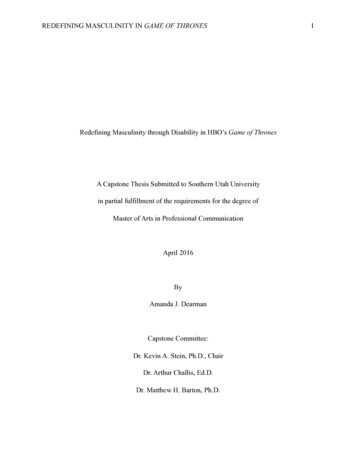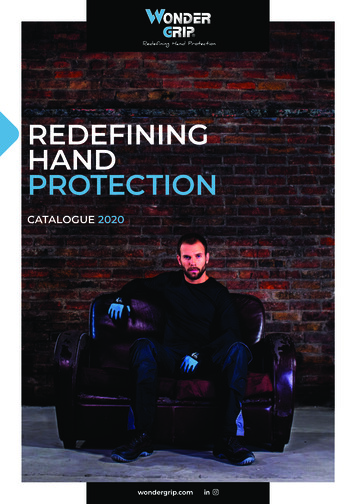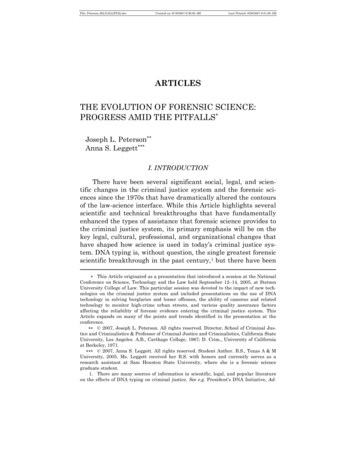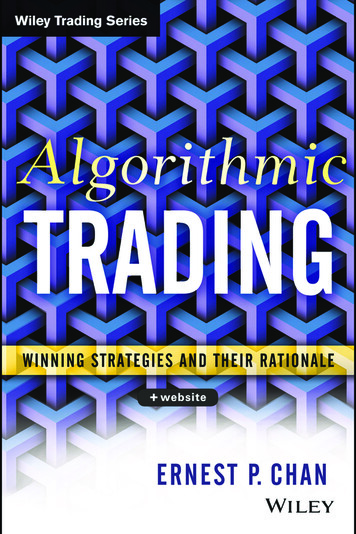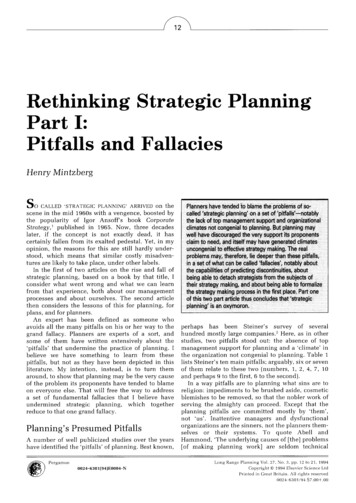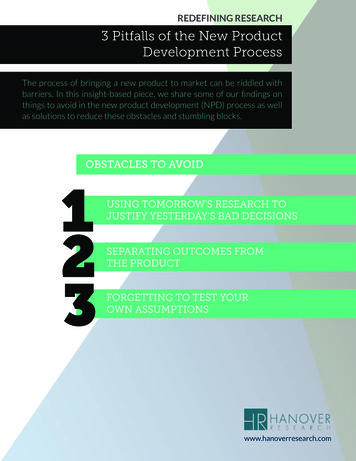
Transcription
REDEFINING RESEARCH3 Pitfalls of the New ProductDevelopment ProcessThe process of bringing a new product to market can be riddled withbarriers. In this insight-based piece, we share some of our findings onthings to avoid in the new product development (NPD) process as wellas solutions to reduce these obstacles and stumbling blocks.OBSTACLES TO AVOID123USING TOMORROW’S RESEARCH TOJUSTIFY YESTERDAY’S BAD DECISIONSSEPARATING OUTCOMES FROMTHE PRODUCTFORGETTING TO TEST YOUROWN ASSUMPTIONSwww.hanoverresearch.com
The Importance of Process in New Product DevelopmentAHarvard Business Review article titledWhy Most Product Launches Fail describes acomponent of the difficulty in new productdevelopment. In discussing whether newproducts will succeed, this research finds that1:Most won’t. According to a leading market researchfirm, about 75% of consumer packaged goodsand retail products fail to earn even 7.5 millionduring their first year. This is in part because of theintransigence of consumer shopping habits. Theconsultant Jack Trout has found that Americanfamilies, on average, repeatedly buy the same 150items, which constitute as much as 85% of theirhousehold needs; it’s hard to get something new onthe radar. Even P&G routinely whiffs with productrollouts. Less than 3% of new consumer packagedgoods exceed first-year sales of 50 million—considered the benchmark of a highly successfullaunch. And products that start out strong may havetrouble sustaining success.We know, then, that many new products do notsucceed. Many products fail to ever make it to themarket, and for those that do, success is not guaranteed.The image below depicts the chances that productswill make it to market and if these products will beultimately successful. While these numbers may varyby market and industry, the message is clear: Bringing acommercially viable product to market is tough to do.240%Products thatmake it tomarketOften discussed but difficult to address, the followingare several major reasons for product launch failure:4 The product falls short of claims and gets bashed. The new item exists in “product limbo”: it fails todistill a true and unmet customer need becauseits benefits are not distinct enough from those ofexisting items, or its features address a transientfad. The product defines a new category and requiredsubstantial consumer education- but does not getit. The product is revolutionary, but there is not amarket for it. The company cannot support fast growth.We know that challenges along the product life cycle,such as the changing marketing, changing customerpreferences, new competitors, poor product design,going after the wrong target market, off-base pricing,off-target go-to-market strategy, and a lack of postlaunch research can result in a shortened product lifecycle. To minimize these challenges, companies shouldconduct research for ideation, validation, developmentof a go-to-market strategy, and post-launch.Our Insights:Through our extensive market research experienceand expertise, we have identified key solutions to useto guide your use of research in the NPD process, aswell as tips for things to avoid during this key process.Chance of NPD Success360%Products thatfail to make it tomarketObstacles along the NPD Cycle60%Generaterevenue to becommerciallyviable40%Fail to becomeprofitableSchneider, J. & Hall, J. 2009. “Why Most Product Launches Fail.” Harvard BusinessReview. ail/ar/1“Guide to New Product Development.” Technology Multipliers. ide-to-new-product-development-npd-90998013Ibid. p. 3.4Schneider, J. & Hall, J. Op. cit.12www.hanoverresearch.com info@hanoverresearch.com
1Using tomorrow’s research to justifyyesterday’s bad decisionsWe know that, too often, companies move forwardwith new products based on a hunch. They havean idea, see value in it, and decide to progress withthe development of a product without thoroughlyexploring the market for that product. However,without thoughtful research and abiding by the knownprinciples of NPD, chances are this company andproduct will encounter difficulties. Then, when theinevitable problems arise, companies look to researchto justify their decisions. Demonstrating this point, anHBR article What Entrepreneurs Get Wrong surveyedentrepreneurs in Hong Kong, Kenya, Mexico, Nigeria,the United Kingdom, and the United States to uncoverinsights on these entrepreneurs’ first sales and whatthey learned through the process. In discussing theirregrets, they shared that “starting late” was a mistakeas they missed out on the crucial opportunity ofunderstanding customer needs and reactions beforeactually developing the product.5Once you’ve developed and rolled out the product,going back to conduct research to guide the product’sdevelopment is not cost-effective or efficient. This cancreate substantial delays in the ultimate progress of theproduct and can deplete morale and potential marketshare by an ineffective rollout.Lesson: Use research to guide the NPD process,rather than trying to correct it once problems arise.Solution: Test and experiment throughout theproduct development process, from inception toproduction. Too often companies first design a productand then figure out a way to sell it. The ultimate successor failure of a product is defined by the customers’willingness to pay for it. Research, experimentation,and testing should therefore be incorporatedthroughout the product development process, ratherthan after the product has already been developed.A few months ago, a prospective Hanover client (thatwill not be named) asked us how we would use researchto ensure the successful launch of their new product:Hanover Research: “Where are you in the productdevelopment process?”Prospective client: “We’re launching the product nextmonth.”HR: “What type of research support are you lookingfor?”PC: “We have the product, we need you to tell us thesize of the market and the best way to sell it before welaunch.”Onyemah, V., Pesquera, M., & Ali, A. “What Entrepreneurs Get Wrong.” Harvard BusinessReview, May 2013. g/ar/16Ibid.5www.hanoverresearch.com info@hanoverresearch.comHR: “But what if we find that there is a poor market foryour product?”PC: “Well it’s too late to change the product now ”We chose not to partner with this organizationbecause they hoped to use research to retroactivelyaffirm decisions to which they had already committed,severely limiting the potential impact of researchon shaping and guiding the NPD process. Furtherdiscussion showed that they had designed a productthat was extremely profitable for them, but ofquestionable value to their customers. After realizinga product is off-target, clients often lament thatthey should have conducted more research tosupport the NPD process. In addition to clienttestimonials, we’ve learned through experience thathad companies such as the one mentioned aboveconducted more thorough research throughoutthe product development process, rather than atthe very end, they would have had time to adjusttheir product to the demands of the market.Unfortunately, they are now stuck with a lemon.2Separating outcomes from the productWhen companies focus entirely on the product itselfrather than also focusing on the sales process, theylose out on valuable knowledge. The NPD processoften focuses on the product itself, but this laser focuscan negatively impact the rollout of the product, asa major component of the process was excluded.Research on mistakes made during product rolloutfinds that “even founders who started selling earlysaid they were too focused on convincing prospects ofthe new product’s merits and not concerned enoughwith finding out what prospects thought of the idea.Some realized that their passion and ego made themrespond negatively to criticism and discount ideas forchanges that they later saw would have increased themarketability of their offerings.”6Understanding the marketing and sales process thatwill accompany the actual product and its merits isa key component of the NPD process. Steps suchas market assessments, product ideation, productvalidation, message testing, and post-launch surveysall play a role in this vital marketing and salescomponent, which cannot be overshadowed by afocus on the product’s merits alone. The success of aproduct is greatly dependent on this knowledge.Lesson: The sales and marketing process of NPDplays a strong role in the success andviability of the product.Solution: Define actionable goals forthe product and hold yourself
accountable to those goals. For example, what minimumprofit margin are you willing to accept for a newproduct? 1 percent? 10 percent? 100 percent? Whendo you need your new product to provide a positivereturn on investment? Within 1 month? 1 year? 2 years?Every business has a unique set of values, competitiveadvantages, and tolerances of risk. As such, youshould define end goals for new products that alignwith your central goals, mission, and appetite for risk.Defining a budget, minimum return on investment, andother baseline measurements of success for all of yournew products before you invest time and resourcesinto developing them ensures that you are not wastingefforts on products that are not profitable or are poorfits for your business model.3Forgetting to test your ownassumptionsStrong assumptions often steer the NPD process;however, these assumptions may take you off course. Astructured research process—rather than assumptions—will guide you towards a successful product launch.The value of conducting research early on in the NPDprocess cannot be overstated. In discussing the twodistinct stages of the NPD process, Bonabeau, Bodick,and Armstrong find that “companies often treat newproduct development as a monolithic process, but it canbe more rationally divided into two distinct stages: atruth-seeking early stage, focused on evaluating novelproducts’ prospects and eliminating bad bets, and asuccess-seeking late stage, focused on maximizingthe value of products that have been cleared fordevelopment.”7 The key takeaway from this finding isthe importance of truth. Your assumptions and hunchesmust be tested and validated before progressing.In The Path to Developing Successful New Products, theWall Street Journal discusses the importance of talkingto the customer throughout the development process.By surveying employees at companies throughoutNorth America and Europe, the researchers found that“the successful innovators in our study kept in closecontact with customers throughout the developmentprocess. More than 80% of the top performers said theyperiodically tested and validated customer preferencesduring the development process, compared with just43% of bottom performers. They were also twiceas likely as the laggards to research what, exactly,customers wanted. That made them better able toidentify and fix design concerns early on, minimizingproject delays.”8 Highlighted in this article is the testingof assumptions through research; so ratherthan proceeding on with the plan (whichwas developed based on assumptionsrather than truths), top performersadjusted their assumptions to reflectresearch throughout the process.Front-end product ideation research through customerfeedback helps companies avoid operating solely onassumptions. A key to the market success of Dysonvacuums was the front-end ideation and developmentresearch conducted before the launch of the first model.With a focus on creating a unique product that was“highly distinctive, broadly appealing, and pragmatic,” aswell as creating “a rigorous capabilities-driven system tosupport these product attributes,” the final product wasunique, reliable, and thoroughly tested by research beforeits release.9Rather than proceeding based on assumptions, externalvalidations through research will test assumptions.Lesson: There is great value in research-baseddefinitions of success and unbiased, external validationsof success.Solution: Incorporate internal and external stakeholderfeedback throughout the product development process.Product development should not occur within a vacuum.A successful product requires someone to sell it, someoneto market it, and most importantly of all, someone to buyit. The perspectives and opinions of consumers, salesstaff, and marketing staff, as well as other key internalstakeholders should be incorporated throughout theproduct development process to ensure that productdesign choices do not prevent future sales. Feedbackcan be incorporated through quantitative surveys orqualitative interviews, depending on the size of thepopulation you intend to reach. For example, surveysare typically the best approach for consumer products,such as outdoor grilling products, while interviews tendto be the best approach for markets with few purchasingdecision makers, such as aircraft components. Invitingoutside perspectives into the product developmentprocess, such as those provided by Hanover or otherresearch firms, can be an excellent method of identifyingbiases or groupthink within an organization before thoseassumptions can permanently affect the success of a newproduct. Hanover’s iterative product concept testingsurveys have identified numerous business to businessand business to consumer products for which markets didnot exist, saving our clients the embarrassment and costsof launching a failed product.Using sound research will help you to steer clear of thesethree identified mistakes to avoid in the NPD process.Bonabeau, E., Bodick, N., & Armstrong, R. “A More Rational Approach to New- ProductDevelopment.” Harvard Business Review, March 2008. new-product-development/ar/18Gordon, M., Musso, C., Rebentisch, E. & Gupta, N. “The Path To Developing Successful NewProducts.” Wall Street Journal, November 30, 2009. 702034401045744005937607203889Kandybin, A. & Michaels, A. “Successful Product Development: Unique, Coherent AndRare.” Forbes, July 29, 2013. -and-rare/7www.hanoverresearch.com info@hanoverresearch.com
HANOVER RESEARCHHanover Research is a global information services firm providing knowledge supportto both non-profit and for-profit organizations. Through our unique, fixed-fee modelwe deliver customized, timely, and authoritative research and advice enabling ourclients to make informed decisions, identify and seize opportunities, and heighten theireffectiveness.Within the for-profit space, B2B and B2C executives apply Hanover Research’s markettrends, competitive intelligence assessments, and data insights to guide productdevelopment, size market opportunities, and gauge brand perception. These insightsinform corporate strategy – enabling companies to work smarter to drive revenue andensure customer satisfaction.Our NPD Approach:Hanover’s research analysts take a systematic approach to help products make it to marketthroughout the entirety of the NPD process:Step 1: Assess New Product OpportunitiesHanover first evaluates the market’s current state, sizes how the initial concept would fit into thecompetitive landscape, and assesses market opportunities and threats.Step 2: Identify Customer Needs and Decision Making ProcessesHanover will conduct interviews or surveys of potential purchasing decision makers to determinepurchasing decision drivers and behaviors. These interviews and/or surveys, combined with theprior market assessment, will clarify the landscape of the market into which clients will introducea new product or service.Step 3: Iterative Product Concept TestingHanover will iteratively test each idea for a new product to determine the optimal productconfiguration. Through rigorous surveys and data analysis, clients understand the costs andbenefits of their product choices and the potential effects that each choice may have on futureearnings.Further Support: Measure and Evaluate New Product SuccessFollowing launch, Hanover develops and implements a custom methodology to measure successof the new product or service over time, providing continuous and up to date information toencourage systematic improvement of the offering.By employing Hanover’s custom research model to guide a product roadmap, companies gainaccess to the knowledge needed for a new product to both thrive and survive in a competitivemarket.To learn more about Hanover Research’s services and our unique model,contact 202.559.0050 or e-mail info@hanoverresearch.comHanover Research1700 K Street, NW 8th FloorWashington, DC 20006P. 202-559-0050E. LOW US FOR ONGOING er-research
3 Pitfalls of the New Product Development Process. The process of bringing a new product to market can be riddled with barriers. In this insight-based piece, we share some of our findings on . be more rationally divided into two distinct stages: a truth-seeking early stage, focused on evaluating novel products' prospects and eliminating bad .

